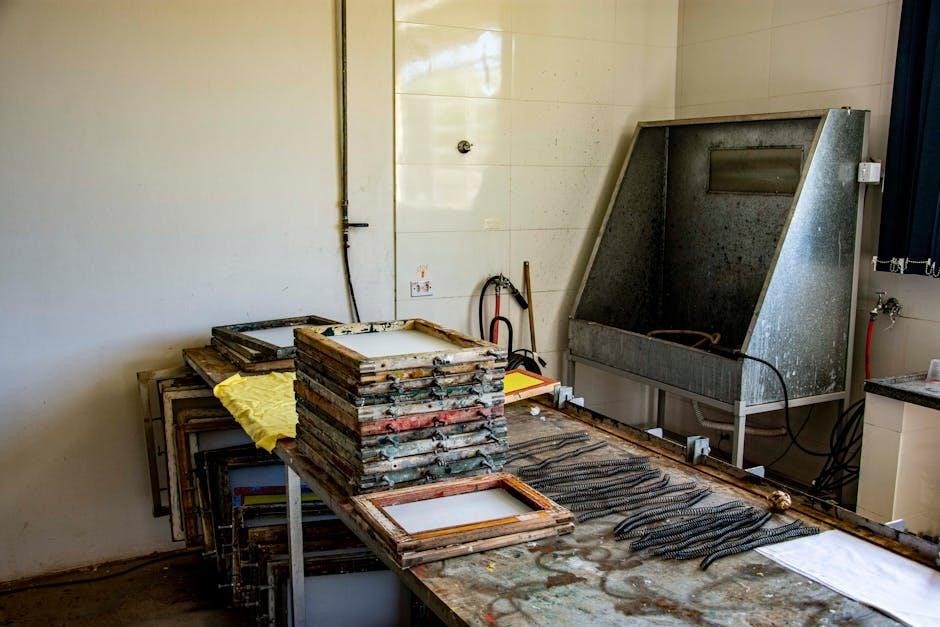
DNA extraction is a fundamental technique in molecular biology, involving the isolation of high-quality DNA from cells. It enables genetic analysis, forensic identification, and research applications, ensuring reliable results.
1.1 Overview of DNA Extraction
DNA extraction involves isolating DNA from cells, ensuring high purity and integrity for downstream applications. Techniques vary, from organic solvents to silica columns, each optimized for specific sample types. The process typically includes cell lysis, protein removal, and DNA precipitation, enabling reliable analysis in genetics, forensics, and diagnostics. Modern methods enhance efficiency and scalability.
1.2 Importance of DNA Extraction in Biological Studies
DNA extraction is a cornerstone in biological research, enabling genetic analysis, molecular diagnostics, and forensic identification. It facilitates the study of genetic disorders, evolutionary relationships, and personalized medicine. High-quality DNA is essential for PCR, sequencing, and gene expression studies, making extraction a critical step in advancing biomedical and forensic sciences globally.
1.3 Applications of DNA Extraction
DNA extraction is vital in forensic science for identifying individuals, solving crimes, and analyzing biological evidence. It is also used in genetic testing, disease diagnosis, and agricultural biotechnology. Additionally, it plays a key role in research, enabling gene cloning, sequencing, and synthesis, thereby advancing medical and biotechnological innovations.

Biological Basis of DNA Extraction
DNA extraction relies on cell lysis to release genetic material, leveraging DNA’s stability and solubility properties. Enzymes like proteinase K digest proteins, while detergents dissolve membranes, enabling DNA isolation.
2.1 Structure and Properties of DNA
DNA’s double-helix structure consists of nucleotides with sugar, phosphate, and nitrogenous bases. Its stability and solubility properties are exploited during extraction, ensuring effective isolation from cellular components for downstream analyses.
2.2 Cell Lysis and DNA Release
Cell lysis involves breaking the cell membrane to release DNA, often using hypotonic solutions or detergents like SDS. Enzymes such as Proteinase K degrade proteins, facilitating DNA release. This step is crucial for isolating DNA from cellular components, ensuring efficient extraction.
2.3 Sources of DNA for Extraction
DNA can be extracted from various sources, including blood, tissues, cells, and plant materials. Blood is a common source, with white blood cells being rich in DNA. Plant sources like leaves or fruits also yield DNA, while tissues require specific protocols for optimal extraction.

Overview of DNA Extraction Methods
DNA extraction methods include organic solvent-based, non-organic solvent-based, and ion exchange chromatography techniques. These methods vary in complexity and efficiency, ensuring high-quality DNA isolation for various applications.
3.1 Organic Solvent-Based Methods
Organic solvent-based methods, such as phenol-chloroform extraction, are widely used for DNA isolation. These techniques rely on the solubility differences between DNA and proteins in organic solvents, allowing efficient separation and purification of DNA from cellular components, ensuring high-quality DNA for downstream applications like PCR and sequencing.
3.2 Non-Organic Solvent-Based Methods
Non-organic solvent-based methods, such as salting-out and silica column techniques, eliminate the need for hazardous chemicals. These approaches use high salt concentrations or silica particles to bind and purify DNA, offering safer, efficient alternatives for DNA extraction. They are widely used in research and clinical settings for their reliability and ease of use.
3.3 Ion Exchange Chromatography Methods
Ion exchange chromatography methods utilize resins that bind DNA based on its negative charge. By adjusting salt concentrations, DNA is selectively eluted, ensuring high purity. This technique is efficient for large-scale DNA extraction and is commonly used in commercial kits due to its consistency and scalability in producing high-quality DNA samples.

Detailed Protocol for DNA Extraction Using Phenol-Chloroform Method
The phenol-chloroform method involves cell lysis, DNA separation using solvents, and precipitation. It effectively removes proteins and contaminants, yielding pure DNA suitable for downstream applications like PCR and sequencing.
4.1 Materials and Reagents Required
The materials include blood samples, EDTA tubes, hypotonic solution, detergents like SDS, enzymes such as proteinase K, phenol-chloroform mixture, sodium acetate, ethanol, and TE buffer. Equipment includes centrifuges, vortex mixers, and microcentrifuge tubes. These materials ensure efficient cell lysis, DNA separation, and purification in the extraction process.
4.2 Step-by-Step Procedure
The process begins with cell lysis using a hypotonic solution and detergents like SDS. Proteinase K digests proteins, followed by phenol-chloroform extraction to separate DNA. DNA is precipitated with ethanol, washed, and resuspended in TE buffer. Each step ensures DNA purification and removal of contaminants, yielding high-quality DNA for downstream applications.
4.3 Advantages and Limitations
The phenol-chloroform method ensures high DNA purity and efficiency, making it widely used. However, it is time-consuming and involves toxic chemicals, posing safety risks. Effective in removing proteins and contaminants, ensuring high-quality DNA. However, handling hazardous materials requires precautions, and the process isn’t ideal for high-throughput applications.
Alternative DNA Extraction Techniques
Alternative methods include salting-out, silica column-based techniques, and commercial kits, offering efficient DNA extraction with high purity and yield for diverse applications.
5.1 Salting-Out Method
The salting-out method uses varying salt concentrations to precipitate DNA. High salt concentrations cause proteins and contaminants to precipitate, while DNA remains soluble. This approach is cost-effective, simple, and suitable for large-scale extractions, producing high-quality DNA for downstream applications like PCR and sequencing.
5.2 Silica Column-Based Methods
Silica column-based methods leverage the binding of DNA to silica particles in the presence of chaotropic agents like ethanol. This technique efficiently removes impurities, ensuring high-purity DNA. It is widely used in commercial kits due to its reliability, scalability, and compatibility with automated systems, making it a preferred choice for consistent DNA extraction.
5.3 Commercial DNA Extraction Kits
Commercial DNA extraction kits offer pre-formulated reagents and streamlined protocols for efficient DNA isolation. These kits are designed for various sample types, including blood, tissues, and saliva, ensuring high yield and purity. They are convenient, time-saving, and minimize contamination risks, making them ideal for both routine and high-throughput applications in research and diagnostics.

Modern Advances in DNA Extraction
Modern DNA extraction integrates automation, magnetic beads, and nanotechnology, enhancing efficiency and precision. These advancements enable rapid, high-quality DNA isolation, reducing manual effort and improving scalability for diverse applications.
6.1 Automation in DNA Extraction
Automation in DNA extraction streamlines processes, reducing human error and increasing throughput. Robotic systems and software-driven platforms enable precise control, ensuring consistent DNA quality. Automated methods are particularly valuable in high-volume settings, such as clinical diagnostics and large-scale research projects, enhancing overall efficiency and reliability.
6.2 Magnetic Bead-Based Extraction
Magnetic bead-based extraction uses paramagnetic particles to bind DNA, simplifying purification. This method offers high efficiency, purity, and scalability. It minimizes contaminants and enables automation, making it ideal for applications requiring rapid and reliable DNA extraction, such as genetic testing and forensic analysis.
6.3 Nanotechnology in DNA Extraction
Nanotechnology enhances DNA extraction by utilizing nanostructured materials like nanoparticles and nanofibers. These materials improve binding efficiency, enabling faster and more selective DNA capture. This method reduces contamination and increases yield, offering a promising alternative for applications requiring high-purity DNA, such as diagnostics and genomics.
Purification and Quality Control of Extracted DNA
Purification involves removing contaminants like proteins and RNA. Quality control includes quantification via spectrophotometry and assessing purity to ensure DNA is suitable for downstream applications like PCR and sequencing.
7.1 DNA Precipitation and Washing
DNA precipitation involves adding ethanol or isopropanol to concentrate DNA, forming a visible pellet; Washing with 70% ethanol removes impurities, enhancing purity. This step is critical for obtaining high-quality DNA, ensuring downstream applications like PCR and sequencing are successful and accurate, free from contaminants that could interfere with reactions.
7.2 Quantification and Purity Assessment
Quantification of DNA is typically performed using spectrophotometry (A260/A280 ratio) to assess concentration and purity. Fluorometry offers higher accuracy for low-concentration samples. Agarose gel electrophoresis visually confirms DNA integrity. These steps ensure the extracted DNA is suitable for downstream applications like PCR, sequencing, and cloning, meeting required quality standards.
7.3 Storage and Handling of DNA Samples
DNA samples are typically stored at -20°C or -80°C to maintain stability and prevent degradation. Handling requires gloves and sterile equipment to avoid contamination. DNA should be protected from light and moisture. Proper labeling and documentation ensure sample traceability. High-quality storage solutions, like TE buffer, help preserve DNA integrity for long-term use.

Applications of DNA Extraction in Various Fields
DNA extraction is crucial in forensic science, genetic testing, and research. It aids in identifying individuals, diagnosing diseases, and advancing genetic studies, making it a cornerstone of modern biology and medicine.
8.1 Forensic Science and DNA Profiling
DNA extraction is pivotal in forensic science for identifying individuals. Techniques like PCR and STR analysis enable profiling from biological samples, aiding criminal investigations and paternity testing. This ensures accurate and reliable identification, crucial for justice and human identity verification.
8.2 Genetic Testing and Diagnostics
DNA extraction is essential for genetic testing and diagnostics, enabling the identification of genetic disorders and inherited diseases. Techniques like PCR and HPLC-DAD facilitate precise analysis of genetic material, aiding in personalized medicine and targeted therapies.
8.3 Research and Development in Genetics
DNA extraction plays a pivotal role in advancing genetic research, enabling scientists to study gene function, sequence genomes, and develop novel biotechnological applications. Efficient extraction methods are crucial for achieving high-quality DNA required in studies such as gene editing and genomic analysis.

Challenges and Considerations in DNA Extraction
DNA extraction poses challenges like contamination, degradation, and inhibition, requiring careful handling to ensure sample integrity and reliable downstream analysis for accurate results.
9.1 Contamination and Inhibition Issues
Contamination during DNA extraction can introduce foreign substances, compromising sample integrity. Inhibitors like proteins, polysaccharides, or chemicals may interfere with downstream processes, necessitating robust purification steps to ensure high-quality DNA for reliable analysis and accurate results.
9.2 DNA Degradation and Shearing
DNA degradation and shearing are critical challenges during extraction. Enzymatic or chemical factors can break DNA strands, reducing fragment size. Proper handling, such as maintaining appropriate pH and temperature, is essential to preserve DNA integrity and ensure suitability for downstream applications like sequencing or amplification.
9.3 Ethical and Safety Considerations
Ethical issues in DNA extraction include privacy concerns and informed consent, especially with human samples. Safety measures are crucial to prevent exposure to hazardous chemicals like phenol or chloroform. Proper waste disposal and protective equipment minimize risks, ensuring a safe working environment while adhering to ethical standards.

Troubleshooting Common Issues in DNA Extraction
Troubleshooting in DNA extraction involves addressing issues like low yield, contamination, or inhibitors. Ensuring proper lysis, optimizing buffers, and using purification steps can mitigate these issues effectively.
10.1 Low DNA Yield
Low DNA yield is a common issue in extraction, often due to insufficient lysis, inadequate reagent concentrations, or excessive RNA contamination. Optimizing cell lysis conditions, ensuring proper buffer ratios, and using RNAase treatments can significantly improve DNA recovery and overall yield. Regularly assessing each step helps minimize this problem effectively.
10.2 High Protein Contamination
High protein contamination in DNA extracts can inhibit downstream processes like PCR and sequencing. Causes include incomplete cell lysis, insufficient protease treatment, or inadequate precipitation steps. Solutions involve optimizing protease digestion, adjusting buffer ratios, or incorporating additional purification steps, such as using silica columns, to effectively remove proteins and ensure pure DNA samples.
10.3 PCR Inhibitors in DNA Samples
PCR inhibitors in DNA samples can interfere with enzymatic reactions, reducing amplification efficiency. Common inhibitors include polysaccharides, phenolics, and proteins. Effective removal methods include silica column purification, magnetic bead technology, or selective precipitation. Ensuring high-quality DNA through optimized extraction protocols minimizes inhibitor presence, improving PCR outcomes and downstream applications.

Future Directions in DNA Extraction Technology
Future advancements focus on automation, miniaturization, and sustainability. Integration with downstream processes, portable devices, and eco-friendly methods aim to enhance efficiency, accessibility, and cost-effectiveness in DNA extraction.
11.1 Miniaturization and Portability
Miniaturization and portability are revolutionizing DNA extraction, enabling point-of-care devices and field-ready kits. Microfluidics and lab-on-a-chip technologies simplify processes, reducing sample volumes and costs. Portable systems enhance accessibility for remote and resource-limited settings, ensuring rapid and reliable DNA extraction for diverse applications, from diagnostics to environmental monitoring, while maintaining high standards of quality and efficiency.
11.2 Integration with Downstream Applications
Modern DNA extraction methods are increasingly integrated with downstream applications like sequencing, PCR, and microarray analysis. Seamless compatibility ensures efficient workflows, reducing processing time and enhancing data consistency. This integration streamlines genetic testing, forensic analysis, and research, making it easier to achieve accurate and reliable results across various biological studies and diagnostic procedures.
11.3 Sustainability and Cost-Effectiveness
Advances in DNA extraction aim to enhance sustainability and cost-effectiveness. Eco-friendly methods reduce chemical use and waste, while automation lowers operational costs. Streamlined protocols and reusable materials further contribute to economical solutions, making DNA extraction more accessible and environmentally responsible for large-scale applications and research settings.
DNA extraction is a cornerstone of molecular biology, enabling advancements in genetics, forensics, and research. Ongoing innovations ensure efficient, sustainable, and high-quality DNA isolation for future applications.
12.1 Summary of Key Concepts
DNA extraction is a critical technique in molecular biology, enabling the isolation of high-quality DNA for various applications. Methods like phenol-chloroform, silica columns, and commercial kits ensure efficient extraction. Quality control, including quantification and purity assessment, is essential for reliable downstream processes. Advances in automation and nanotechnology promise improved efficiency and sustainability in DNA isolation.
12.2 Final Thoughts on the Evolution of DNA Extraction Techniques
The evolution of DNA extraction techniques reflects advancing technology and scientific understanding. From traditional phenol-chloroform methods to modern automation and nanotechnology, these innovations enhance efficiency, purity, and scalability. Future advancements promise even greater accessibility, sustainability, and integration with downstream applications, driving progress in genetics, diagnostics, and research.
 contrat de sous-location québec pdf
contrat de sous-location québec pdf  textes avec fautes à corriger pdf
textes avec fautes à corriger pdf  the mark of athena pdf
the mark of athena pdf  chaupai sahib pdf in english
chaupai sahib pdf in english  packing list for cuba all inclusive pdf
packing list for cuba all inclusive pdf  par iii herbicide mixing instructions
par iii herbicide mixing instructions  king of the underworld rj kane pdf
king of the underworld rj kane pdf  merlin home transmitter manual
merlin home transmitter manual  mark cousins the story of film pdf
mark cousins the story of film pdf